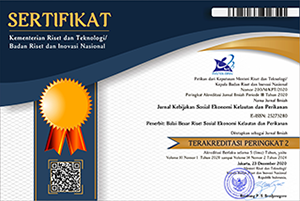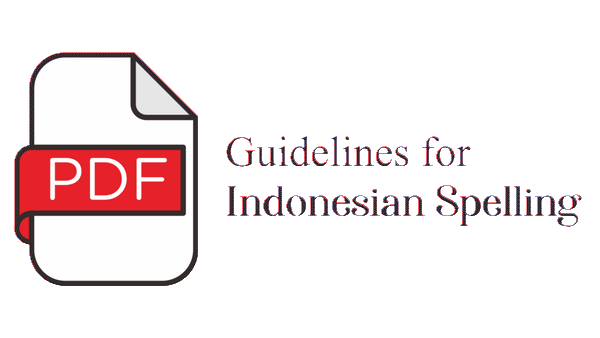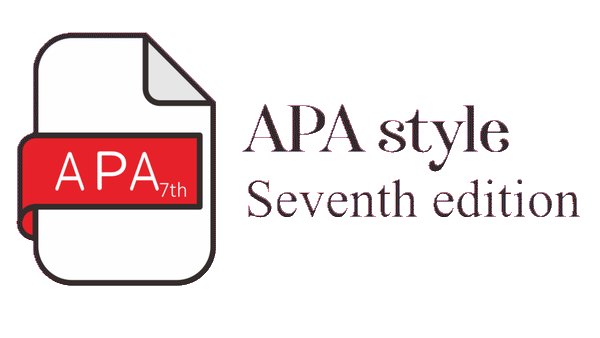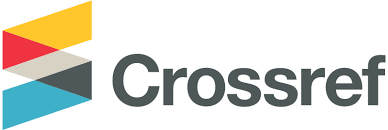DETERMINAN PERMINTAAN EKSPOR KEPITING/RAJUNGAN OLAHAN INDONESIA KE AMERIKA SERIKAT: PENDEKATAN ERROR CORRECTION MODEL
Abstract
Kepiting/rajungan merupakan salah satu komoditas ekspor perikanan yang terus meningkat permintaannya. Penelitian ini bertujuan menganalisis permintaan ekspor kepiting/rajungan olahan Indonesia ke Amerika Serikat sebagai pasar tujuan utama. Data yang digunakan adalah data sekunder, yaitu data harga ekspor kepiting/rajungan Indonesia ke Amerika Serikat, volume produksi kepiting/rajungan di dalam negeri, dan nilai tukar rupiah terhadap dolar Amerika Serikat. Data tersebut diperoleh dari UN-Comtrade, Kementerian Kelautan dan Perikanan (KKP), dan Badan Pusat Statistik (BPS). Metode analisis data yang digunakan adalah ekonometrika dinamis dengan pendekatan Error Correction Model (ECM). Hasil penelitian menunjukkan bahwa variabel yang memiliki pengaruh terhadap permintaan ekspor kepiting/rajungan Indonesia ke Amerika Serikat pada jangka pendek adalah harga ekspor dan volume produksi di dalam negeri dengan nilai koefisien masing-masing sebesar -0.7818 dan 0.5270. Pada jangka panjang, variabel yang berpengaruh adalah harga ekspor kepiting/rajungan Indonesia ke Amerika Serikat dengan nilai koefisien sebesar - 0.7938. Upaya peningkatan volume ekspor kepiting/rajungan Indonesia ke Amerika Serikat dapat dilakukan dengan kebijakan melalui usaha nelayan dan perbaikan mekanisme rantai pasok (foodchains) yang berdampak menurunkan harga ekspor kepiting/rajungan Indonesia ke Amerika Serikat dan perbaikan kualitas produksi kepiting/rajungan di Indonesia. Selain itu, seiring dengan meningkatnya permintaan kepiting/rajungan di Amerika Serikat dapat memberikan peluang bagi Indonesia untuk meningkatkan ekspor kepiting/rajungan ke Amerika Serikat.
Title: Determinants of Demand for Indonesian Export of Processed Crabs to the United States: An Error Correction Model Approach
Crab is one of fishery export commodity that has continuing increase in demand. This study aimed to analyze demand for Indonesian processed crab exports to the United States as the main destination market. Data used are secondary data, namely data on export price of Indonesian crabs to the United States, the volume of domestic crab production, and exchange rate of the rupiah against the US dollar. Data was obtained from UN-Comtrade, Ministry of Marine Affairs and Fisheries (KKP), and Central Statistics Agency (BPS). Data were analyzed using dynamic econometrics method with the Error Correction Model (ECM) approach. Variables of the study are export price of Indonesian crab to the United States, production volume of crab in Indonesia, and exchange rate of rupiah against United States dollar. The results showed that export prices and domestic production volume are variables influencing demand for Indonesian crab exports to the United States in the short term with coefficient value of -0.7818 and 0.5270 respectively. In the long term, the influencing variables is domestic production volume with coefficient value of 0.7938. Export volume to the United States could be increased through policy on fishing effort and supply chain mechanism improvement that resulted in the decrease of export prices and improved quality of the crabs. In addition, the increasing number of crab demand in the United States provides opportunities for Indonesia to increase crab exports to the United States.
Keywords
Full Text:
PDFReferences
Abidin, I. S. Z., Haseeb, M., Azam, M., & Islam, R. (2015). Foreign direct investment, financial Development, international trade and energy consumption: Panel data evidence from selected ASEAN Countries.
International Journal of Energy Economics and Policy, 5(3), 841-850.
Agustina, E.R., Mudzakir, A.K., & Yulianto, T. (2014). Analisis Distribusi Pemasaran Rajungan (Portunus Pelagicus) di Desa Betahwalang Kabupaten Demak. Journal of Fisheries Resources Utilization Management and Technology, 3(3), 190-199.
https://ejournal3.undip.ac.id/index.php/jfrumt/article/view/5543.
Bahtiar, R., Nuva, Anggraeni, D., & Hidaya, N.K. (2016). Economic evaluation of implementing minimum legal size on blue swimming crab fishery in Indonesia. Marine and Coastal Ecosystem Valuation, Institution, and Policy in Southeast Asia, 341-363. https://doi.org/10.1007/978-981-10-0141-3_17.
[BKIPM] Badan Karantina Ikan, Pengendalian Mutu, dan Keamanan Hasil Perikanan. (2018). Data Operasional BKIPM Tahun 2016 dan 2017. Jakarta, ID: Badan Karantina Ikan, Pengendalian Mutu, dan Keamanan Hasil Perikanan, Kementerian Kelautan dan Perikanan.
Catão, L. & Falcetti, E. (2002). Determinants of Argentina’s External Trade. Journal of Applied Economics, 5(1), 19-57. https://doi.org/10.1080/15140326.2002.12040570.
de-Graft Acquah, H., & Acquah, J.D. (2015). An application of the error correction model in analyzing the long run equilibrium between Ghana’s exports and imports. APSTRACT: Applied Studies in Agribusiness and Commerce, 9(3), 57-62. DOI: 10.19041/APSTRACT/2015/3/8.
Engle, R.F. & Granger, C.W.J. (1987). Co-integration and error correction: representation, estimation, and testing. Econometrica, 55(2), 251-276. DOI: 10.2307/1913236.
Fahmi, A.S., Maksum, M. & Suwondo, E. (2015). USFDA import refusal and export competitiveness of Indonesian crab in US market. Agruculture and Agricultural Science Procedia, 3(2015), 226-230. DOI: 10.1016/j.aaspro.2015.01.044.
Granger, C.W.J. & Newbold, P. (1974). Spurious Regressions in Econometrics. Journal of Econometrics, 2(2), 111-120. https://doi.org/10.1016/0304-4076(74)90034-7.
Greene, W.H. (2018). Econometric Analysis, 8th edition. New York, US: Prentice Hall.
Hapsari, R.D. & Prakoso, I. (2016). Penanaman Modal dan Pertumbuhan Ekonomi Tingkat Provinsi di Indonesia. Jurnal Ekonomi dan Bisnis, 19(2), 211-224. https://doi.org/https://doi.org/10.24914/jeb.v19i2.554.
Khasanah, U., Huang, W.C., & Asmara, R. (2019). Indonesian frozen and processed crab export performance and competitiveness analysis. Agricultural Socio-Economics Journal, 19(3), 165-171. DOI: http://dx.doi.org/10.21776/ub.agrise.2019.019.3.5.
[KKP] Kementerian Kelautan dan Perikanan. (2019). Statistik KKP, Produksi Perikanan. Retrieved
fromhttps://statistik.kkp.go.id/home php?m=total&i=2.
Labandeira, X., Labeaga, J.M., & Lopez-Otero, X. (2017). A meta-analysis on the price elasticity of
energy demand. Energi Policy, 102(2017), 549-568. DOI: http://dx.doi.org/10.1016/j.enpol.2017.01.002.
Laoli, N. (2015). Populasi susut, ekspor kepiting dan rajungan turun. Kontan.co.id Senin, 11 Mei 2015 /17:05 WIB. Retrieved from https://industri.kontan.co.id/news/populasi-susut-ekspor-kepiting-dan-rajungan-turun, diakses tanggal 24 November 2016.
Maghfuriyah, A., Azam, S.M.F., & Shukri, S. (2019). Market structure and Islamic banking performance in Indonesia: An error correction model. Management Science Letter, 9(9), 1407-1418. DOI: 10.5267/j.msl.2019.5.010.
Maulana, A. G. (2015). Permintaan Ekspor Berkurang, Harga Rajungan Anjlok. Bisnis.com: 28 September 2015 21:35 WIB. Retrieved from http://industri.bisnis.com/read/20150928/
/476800/permintaan-ekspor-berkurang-harga-rajungan-anjlok, diakses tanggal 24 November 2016.
Mulyani, D. & Hartono, D. (2018). Pengaruh
Efisiensi Energi Listrik pada Sektor Industri dan Komersial terhadap Permintaan Listrik di Indonesia. Jurnal Ekonomi Kuantitatif Terapan, 11(1), 1-17. Doi: https://doi.org/10.24843/JEKT.2018.v11.i01.p01.
Munadi, E. (2007). Penurunan pajak ekspor dan dampaknya terhadap ekspor minyak kelapa sawit Indonesia ke India (pendekatan error correction model). Informatika Pertanian, 16(2), 1019-1036. DOI: 10.30908/bilp.v1i3.303.
Oesterling, M.J. (1998). “Blue” crab resources in other countries: implications for the US industry. Journal of Shellfish Research, 17(2), 375-378. https://scholarworks.wm.edu/vimsarticles/493.
Prahadi, Y.Y. (2016). Dongkrak Ekspor, Pemerintah Galakkan Budidaya Rajungan dan Kepiting.
SWA 21 Oktober 2016. Retrieved from https://swa.co.id/swa/business-strategy/dongkrak-
ekspor-pemerintah-galakkan-budidaya-rajungan-dan-kepiting, diakses tanggal 24 November 2016.
Pramahesti, K., & Hartono, D. (2020). Energy, Economic Growth, and Financial Development in ASEAN+3. Signifikan: Jurnal Ilmu Ekonomi, 9(1), 137-152. Doi: http://dx.doi.org/10.15408/sjie.v9i1.13536.
Rahmawati, D.A.D & Hidayat R, W. (2017). Analisis pengaruh suku bunga Sertifikat Bank Indonesia dan Jumlah uang beredar terhadap
tingkat inflasi di Indonesia periode 2006.
-2015.12 (pendekatan error correction model). Jurnal Ilmu Ekonomi, 1(1), 60-74.http://ejournal.umm.ac.id/index.php/jie/article/view/5409/5235.
Riniwati, H., Harahab, N., & Carla, T.Y. (2017). Analysis of Indonesian crab export competitiveness in international market. International Review of Management and Marketing, 7(5), 23-27. https://www.econjournals.com/index.php/irmm/article/
view/5576/pdf.
UN COMTRADE. (2018). United Nations commodities trade statistics database. https://comtrade.un.org/data/.
Verbeek, M. (2017). A Guide to Modern Econometrics, 5th edition. New York, US: John Wiley & Sons.
Voldnes, G., Kvalvik, I., & Nøstvold. (2020). Taking care of a highly valuable resource throughout the
value chain – Lack of market orientation in red king crab ecport? Marine Policy, 117(2020), Article 103965. https://doi.org/10.1016/j.marpol.2020.103965.
Wahyuni, D., Purnastuti, L., & Mustofa, M. (2016). Analisis elastisitas tiga bahan pangan sumber protein hewani di Indonesia. Jurnal Economia, 12(1), 43-53. Doi:10.21831/economia.v12i1.9544.
Widarjono, A. (2016). Ekonometrika Teori dan
Aplikasinya. First Edition. Yogyakarta: Ekonisia.
Widyawati, S. & Wahyudi, S.T. (2016). Determinan pertumbuhan kredit modal kerja perbankan di Indonesia: Pendakatan error correction model (ECM). Jurnal Keuangan dan Perbankan, 20(1), 149-156,
http://jurnal.unmer.ac.id/index.php/jkdp/article/view/159/pdf.
Wulandari, A. (2018). Quality control strategy on crab handling process by using Analytical Hierarchy Process Method. Agricultural Science, 1(2), 93-103. http://agriscience.scientific-work.org/index.php/agriscience/article/view/10.
Zhang, H., Kuuluvainen, J., Lin, Y., Gao, P., & Yang, H. (2017). Cointegration in China’s log import demand: price endogeneity and structural change. Journal of Forest Economics, 27(2017), 99-109. http://dx.doi.org/10.1016/j.jfe.2017.03.003.
Zhu, X., Li, L., Zhou, K., Zhang, X., & Yang, S. (2018).
A meta-analysis on the price elasticity and
income elasticity of residential electricity demand. Journal of Cleaner Production, 201(2018), 169-177. DOI: https://doi.org/10.1016/j.jclepro.2018.08.027.
DOI: http://dx.doi.org/10.15578/jksekp.v10i2.9271
Indexed by:
---------------------------------------------------------------------------------------
Published by
Research Center for Marine and Fisheries Socio-Economic
in collaboration with
Indonesian Marine and Fisheries Socio-Economics Research Network
This work is licensed under a Creative Commons Attribution-NonCommercial-ShareAlike 4.0 International License.













3.png)











